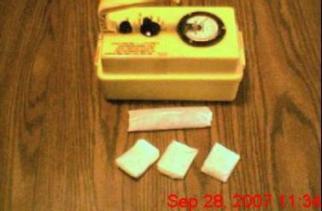
*Make Your Own Desiccant Packs and Save!*
Several industries use desiccant packs. We find them in electronic equipment, technical instruments, optics, musical instrument cases and many other places. Few individuals have much use for them, however, and as a result they tend to get tossed out or left forgotten about.
But we use them, in gun cabinets, radiological monitoring equipment, etc. It’s hard to find brand-new desiccant packs. You can buy canisters for gun lockers and so forth, but they’re needlessly expensive. The gun store in my town sells gun-locker canisters that are about the size of an Altoids tin for something like $15.00. Even more expensive for their size are the little packets you see occasionally on sale in surplus catalogues. I recently saw a catalogue selling “new” surplus desiccant packs at $4.99 for five!
Now suppose I told you that you can make your own, using fresh, brand-new-never-used-non-surplus silica gel in about a minute for as little as 15¢ apiece.

This article will show you how.
You will need:
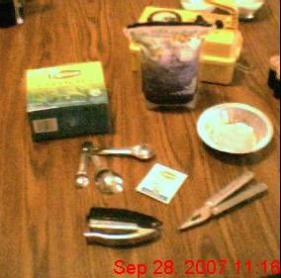
You want tea bags that are held closed by a staple:
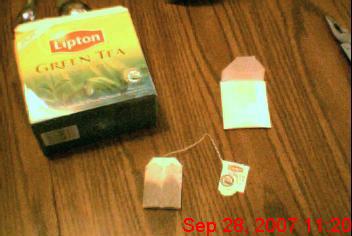
You could use the bonded-together type bags, but they wouldn’t hold as much and it’s a bit of a hassle trying to close them. We will use Lipton bags in our article.
Silica gel in bulk is easier to find than you might imagine; but like all things worth finding, you must know where to look. Go to the artsy-craftsy store in your town. If you don’t know where it is or don’t think you have one in your town, ask your wife—trust me, it’s there, but you just never noticed it.
Ask the lady working there where they keep the stuff for preserving flowers. She may never have heard of “silica gel” but she’ll know where the flower-drying stuff is and it’s the exact same thing. If you think you need a “cover,” just wink and smile and tell her your anniversary is tomorrow. She will sigh and beam, and then guide you either to the aisle with the phony flowers or the one with the bridal stuff. You will find silica gel there.
It will come either in a margarine tub or a re-sealable plastic bag. The plastic bag holds a pound and ought to cost around $5.00.
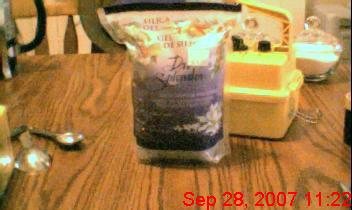
Buy one. You probably don’t need any more.
Once home, assemble everything in one place; the dining room table if you’re brave, the workbench if you’re not, the coffee table in the living room if you’re foolhardy. Upon taking your first teabag out of its paper pouch—the Russians call it “Postman’s Tea” because it comes in envelopes—you will notice that it’s held closed with the World’s Smallest Staple.
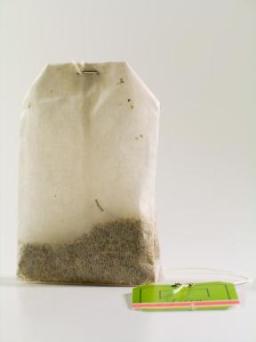
This you will remove with the pliers, prying apart one tiny arm at a time. You could just rip it out but you want your finished product to have a workmanlike appearance, so take your time. It’s not difficult and comes out with next to no effort. Drop it in the dish or paper plate.
You will also notice, if you’re using Lipton bags, that they are a sort of cheesecloth tube (I don’t know what the material is but it looks like cheesecloth and it isn’t really that important anyway), folded in half with tea on both sides.
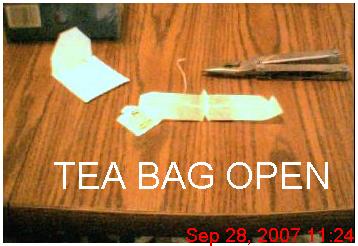
Unfold the bag, and dump the tea out onto the paper plate. Shake the little bits out but it isn’t necessary to get every last particle.
You could measure the amount of tea in the bag and replace it with a like amount of silica gel. Or you could take my word for it when I tell you that there is about a teaspoon’s worth of tea in the bag. It doesn’t look like much until you remember that it’s one teaspoon’s worth of dry tea in the bag; after steeping in water, the contents swell up to about three times their normal volume, or about a tablespoon’s worth.
The upshot is that the bag will hold much more than it does originally.
For my purpose, I split the difference and poured one teaspoon of silica gel in each half. It fits quite nicely.
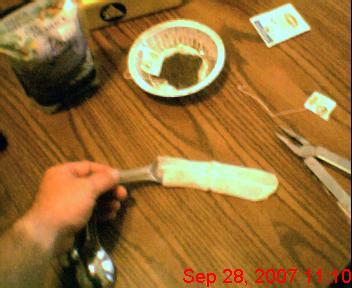
You may put less or more in depending on how much silica gel you want in your pack or how much room you have in the space where the pack is going.
A WORD OF CAUTION:
Silica gel is of course very dry, VERY slick and comes in little ball-shaped grains, about half the size of a peppercorn, that bounce and roll crazily when loose. Some care is necessary not only spooning the stuff out of the bag or tub and into your teabags, but also in opening the bags or tubs for the first few times. 1lb bags are packed VERY full. Carelessly opening these containers the first time will cost you about an hour vacuuming all the little crystals up off the floor.
To finish, simply fold the ends up like they were before and staple:
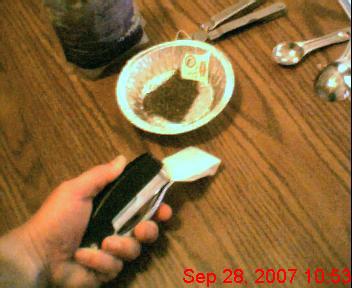
You can fit quite a volume in a teabag by stapling one end and filling it up like a sausage:
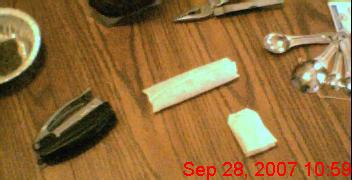
It’s a fine thing for a larger volume container such as a PVC tube, a larger ammo can or a small gun cabinet.
Remember to close the tub or bag as carefully as you opened it.
Estimating the cost of tea bags at $2.00 per box of 20 (get ‘em on sale), the cost of silica gel at $5.00 a pound and a penny per staple; and that (conservatively) I could get a hundred desiccant packs out of said one pound bag, the cost per desiccant pack is around 14¢ apiece. Better than the $4.99 per four or five you sometimes see in the surplus catalogues. They each take about a minute to make, start-to-finish, so it’s well worth the time, especially if you have several to put together. They are just as reusable as surplus ones and can be dried the same way (see FNV Re-vamping Desiccant Packs)
gvi
www.alpharubicon.com
All materials at this site not otherwise credited are Copyright © 1996 - 2007 Trip Williams. All rights reserved. May be reproduced for personal use only. Use of any material contained herein is subject to stated terms or written permission.